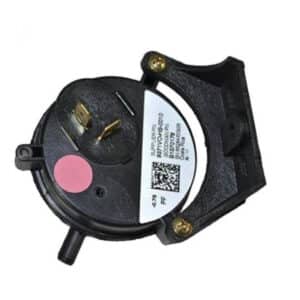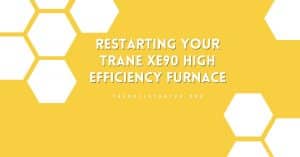A common issue homeowners may face with their Goodman furnace is displaying an F02 error code. This technical hiccup, while concerning, is not insurmountable. I’ll delve into the F02 error code — what it signifies, the underlying causes, and actionable steps you can take to troubleshoot and resolve this issue effectively.
Understanding Error Codes in Goodman Furnaces
Goodman furnaces are praised for their efficiency and reliability as home heating solutions. They are notably equipped with an intelligent diagnostic system communicating via error codes. These codes are not arbitrary alerts but sophisticated language crafted to identify specific operational issues within the furnace. For homeowners, comprehending these codes is vital for several reasons.
Initially, these error codes serve as the furnace’s method of communication. When an issue arises, the furnace exhibits a specific code through the LED light on the control board, pinpointing a particular problem. This feature is critical for immediate diagnosis. Rather than speculating about potential issues when your furnace acts up, these codes provide direct insight into the problem related to the ignition system, the blower motor, or airflow complications.
Additionally, understanding these Goodman error codes is key to effective furnace maintenance. This not only prolongs the life of your furnace but also ensures its peak efficiency, leading to savings on energy costs and reducing the need for unnecessary repairs.
What is the F02 Error Code On Goodman Furnace?
The F02 error code on a Goodman furnace is a significant indicator pointing to a specific issue related to the furnace’s pressure system. This error typically suggests that there is not enough vacuum in the pressure switch to allow it to close, which is essential for the furnace’s operation.
When the pressure switch doesn’t close, the furnace won’t run, leading to heating issues in your home.

Several factors can contribute to this lack of sufficient vacuum in the pressure switch:
- Pressure Switch Hose Issues: If the pressure switch hose is blocked, pinched, cracked, or improperly connected, it can impede the necessary vacuum for the switch to function correctly.
- Blocked Flue or Weak Induced Draft Blower: The flue, which expels exhaust gases, can become blocked, or the induced draft blower, responsible for moving air and gases through the furnace, might be weak or failing. Either situation can affect the pressure switch operation.
- Pressure Switch Problems: The error might stem from an incorrect pressure switch setpoint, or the switch contacts might malfunction. This would prevent the switch from detecting the correct pressure levels.
- Wiring Issues: Loose or improperly connected wiring related to the pressure switch circuit can also be a culprit, leading to a lack of necessary electrical signals.
- Flue or Chimney Blockage: Any blockage in the flue or chimney can disrupt the normal exhaust flow, impacting the pressure levels within the furnace system.
- Water in Heat Exchanger: Water backing up in the heat exchanger or the furnace’s drain system can also impact the pressure levels, potentially triggering the F02 error code.
Addressing the Goodman furnace code F02 involves systematically checking these potential causes and rectifying any issues found. It’s important to approach this troubleshooting with care, as it involves critical components of the furnace. In many cases, especially where electrical or gas components are involved, it might be safest and most effective to consult a professional HVAC technician.
Troubleshooting and Repairing the F02 Code on Goodman Furnaces
A systematic approach is essential when troubleshooting the F02 error code on a Goodman furnace. Start by ensuring the operational status of the small vent motor. This component is crucial in generating the required vacuum for the pressure switch to function correctly.
If you find no obstruction or water backup, proceed with additional troubleshooting steps. One effective method involves disconnecting the rubber hose from the inducer while keeping it attached to the switch. Then, call for heat at the thermostat and gently suck on the hose. Listen for a clicking sound from the switch and observe if the burners ignite. This step helps determine if the pressure switch is operating correctly.
Another useful technique is to bypass the pressure switch with a jumper once the inducer starts. This action simulates the closed state of the switch. If the furnace lights up after this, it indicates an issue with the pressure switch or its circuitry.
Consider using a vacuum manometer or a Magnehelic gauge for a more technical assessment, especially if the above steps don’t yield results. These tools measure whether the inducer pulls the switch’s appropriate vacuum. The vacuum level should meet or exceed the amount required to close the switch or be 20% higher than the vacuum level needed to open it, as specified on the switch’s label. This technical testing can provide a more accurate diagnosis of the issue, guiding further repair actions.
Other components that need to be checked:
- Verify Inducer Motor Operation
- Ensure that the inducer motor is running as it should be. This motor creates the necessary vacuum to engage the pressure switch. If it’s not operational, the pressure switch may not close due to a lack of vacuum.
- Inspect the Pressure Switch Hose
- Examine the hose connected to the pressure switch for blockages, pinches, cracks, or improper connections. These issues can prevent the pressure switch from closing properly.
- Check the Flue and Induced Draft Blower
- Make sure the flue is clear of any obstructions. A blocked flue can disrupt the vacuum necessary for the pressure switch.
- Confirm that the induced draft blower is functioning correctly. A weak blower might fail to create the needed vacuum.
- Check Pressure Switch Settings
- Verify that the pressure switch’s setpoint is correct. Faulty switch contacts can prevent the switch from closing properly.
- Verify Wiring Connections
- Ensure all wiring related to the pressure switch is securely and correctly connected. Loose or improper connections can interfere with the switch’s functioning.
Remember, while some homeowners may feel comfortable performing basic checks and simple troubleshooting, professionals best handle more technical steps involving special equipment. If in doubt or the problem persists, seeking assistance from a qualified HVAC technician is advisable for a safe and effective resolution.
In summary, tackling the Goodman furnace code F02 involves a combination of straightforward troubleshooting and potentially more in-depth technical diagnostics. This error code indicates an issue with the vacuum needed for the pressure switch to operate, which may arise from various causes, from simple blockages to more complex faults within the pressure system.
The recommended steps, including checking the vent motor and inducer operation, inspecting for blockages, and using tools like a vacuum manometer, aim to help you pinpoint and fix the underlying cause of the F02 error. While some homeowners might feel comfortable performing these steps, it’s important to know when to seek professional assistance, particularly for complicated furnace parts or when specialized diagnostic equipment is needed.
By correctly addressing issues signaled by error codes such as F02, you not only enhance the efficiency of your Goodman furnace but also contribute to its longevity. This is key for maintaining the comfort and safety of your home. If the issue persists despite your efforts, or if you are unsure about any procedures, promptly contacting a professional HVAC technician is advisable. Their expertise and experience are crucial for safely and accurately resolving your furnace problems.






